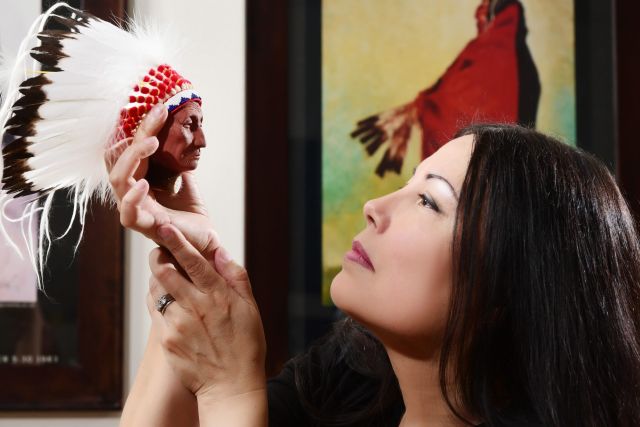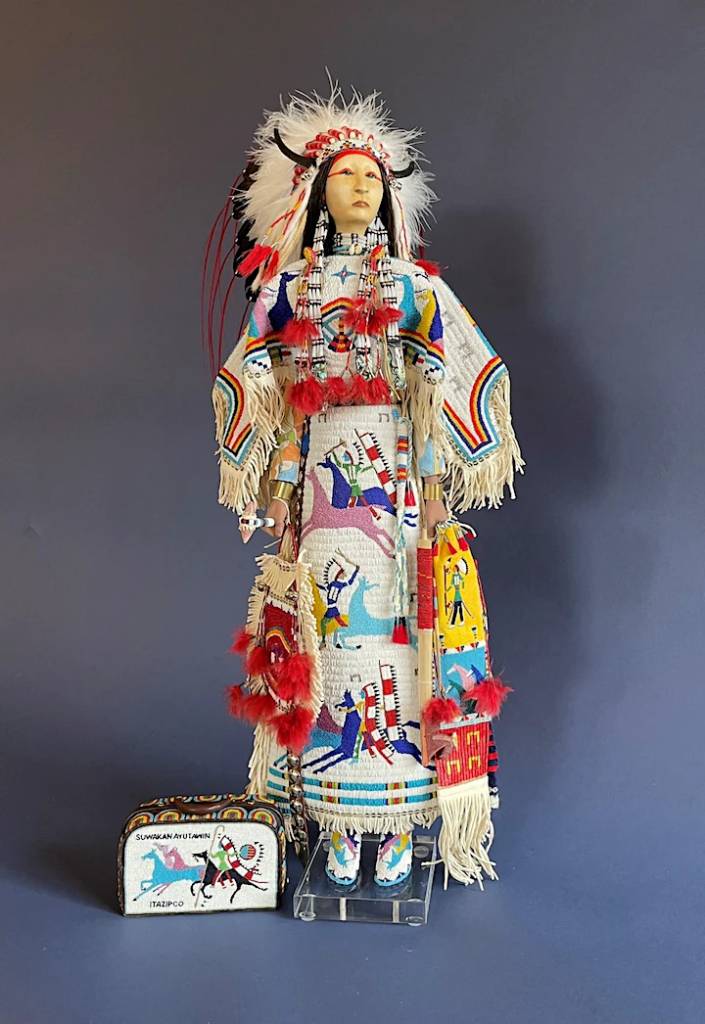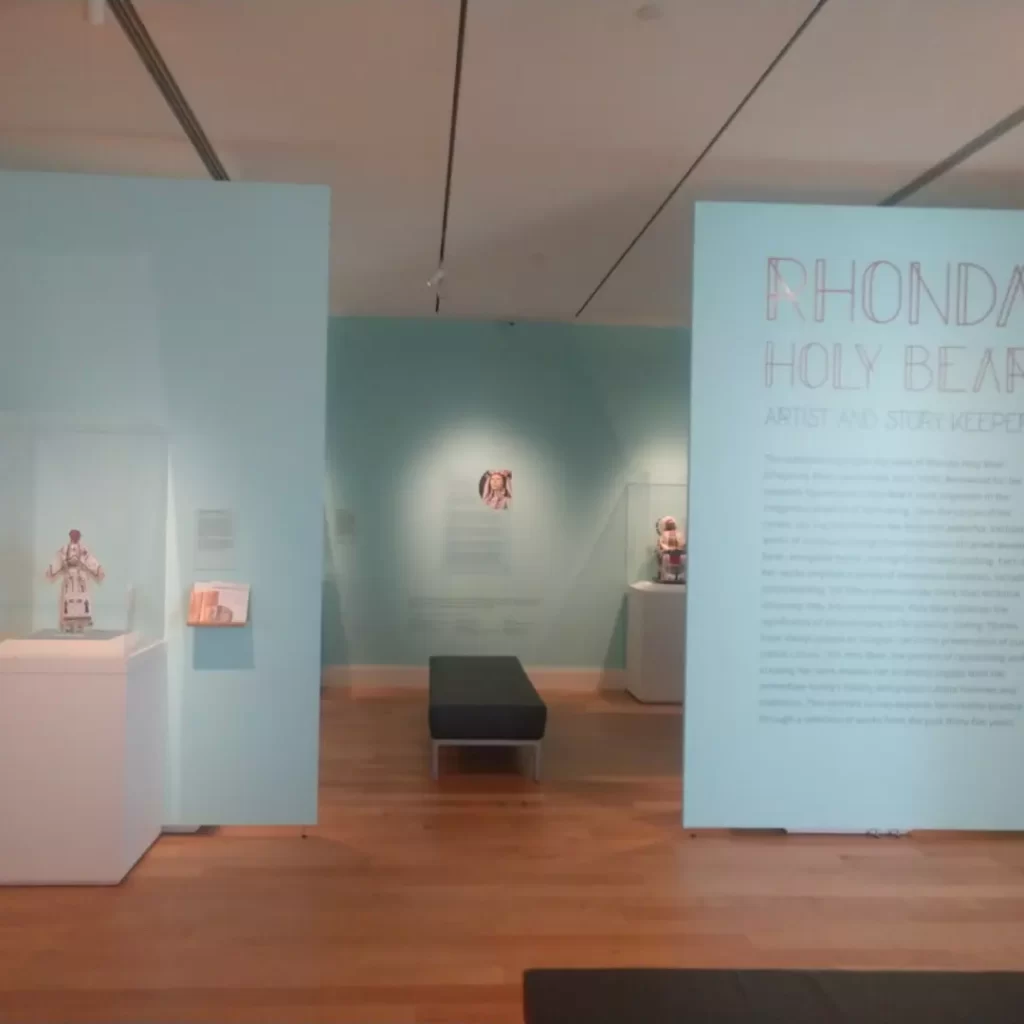Last week I talked about the Doll Gallery reinstallation at the Barry Art Museum, which included the formation of a new temporary space for rotating shows. Today, we’ll look at the inaugural exhibition for that space, Rhonda Holy Bear: Artist and Story-Keeper. This show came together at the same time as the Doll Gallery, our reasoning being that since the temporary gallery was being created as part of the overall reinstallation, they should open together. It made a few frenetic months, but we’re happy with the result.

This exhibition highlights the work of Rhonda Holy Bear (Cheyenne River Lakota tribe). Renowned for her exquisite figurative art, Holy Bear’s work originates in Indigenous practices of dollmaking. Over the course of her career, she has transformed her dolls into powerful, intricate works of sculpture through the introduction of carved wooden faces, elongated forms, and highly decorated clothing. Each of her works employs a variety of meticulous processes, including micro-beading.
Yet these pieces convey more than technical virtuosity; they are story-keepers. Holy Bear observes the significance of story-keeping to her practice, stating “Stories have always played an integral role in the preservation of our native culture.” For Holy Bear, the process of researching and creating her work enables her to deeply engage both her immediate family’s history and greater Lakota histories and traditions. This intimate survey explores her creative practice through a selection of works from the past thirty-five years.
Given that the temporary gallery is a small space, this is an intimate show. There are a total of six pieces in the exhibition, including five works from Holy Bear and one example of a historical Lakota doll to show visitors the kind of work that initially inspired the artist. Yet this intimate scale works in the show’s favor because it allows viewers to spend time with each piece and linger over the details. Rhonda Holy Bear’s work takes time to fully appreciate, from the remarkable microbeading to the delicate carving of the faces. It isn’t a show you can rush through, so by having a few pieces, visitors can take their time in appreciating them.
While all of the works are incredibly powerful and beautiful, the centerpiece is undoubtedly Rhonda Holy Bear’s most recent work, Lakota Honor- Sees The Horses Woman-Suwakan Ayutan Win. This exquisite sculpture offers a stunning visual meditation on memory. It is a multilayered piece that commemorates both personal family history and Lakota histories, with elaborate handmade clothing depicting different narrative scenes.

Each element of this work expresses symbolic meaning. The figure represents Holy Bear’s grandmother, Josephine Sees the Horses Woman, as well as an idealized Lakota woman wearing battle regalia to honor the memory of a male relative. In traditional Lakota culture, women are not allowed to wear or use such regalia unless they are honoring a male relative who has died in battle. Once a year, she dons his regalia ceremonially, preserving his memory through wearing the objects and recounting his exploits. In this piece, these exploits are recounted through the micro-beaded scenes stitched into the dress, with individual layers of her garment revealing different stories. Through this piece, Holy Bear creates a visual embodiment of oral histories through narrative beadwork.
While Holy Bear’s work is the focal point of the exhibition, we did introduce technological elements in the form of a didactic video. Given the multi-layered richness of Lakota Honor- Sees The Horses Woman-Suwakan Ayutan Win, with Holy Bear’s permission the museum recorded a video of the piece with each of the layers of clothing moved or lifted to show the hidden details underneath. Holy Bear also narrated the video, talking visitors through the work.
As with other Barry Art Museum projects, collaboration was an important element of Rhonda Holy Bear: Artist and Story-Keeper, arguably even more so since were featuring the work of an Indigenous artist. From the onset of the project, our top priority was making sure Holy Bear was the primary interpretive voice in the show. As a white woman, one of my most important roles as curator is stepping back and empowering people to tell their own stories. Going into this show, I knew that I couldn’t write about Rhonda Holy Bear’s work in the same way as I would for the automata, for instance, or French bebes. Her deeply personal work is rooted in powerful Indigenous histories and creative practices while also pushing them in new directions, and I wanted to make sure visitors experienced the show through her voice.

Throughout the entire curatorial process then, we made sure Rhonda Holy Bear was closely involved. We painted the gallery light blue at her request, as she explained that it’s a spiritually significant color to her practice. I worked directly with Holy Bear to make sure the exhibition text reflected her perspectives, and everything I wrote was based on conversations we’d had over the phone or through Zoom. I also had her read all the texts and didn’t send anything to print until she approved them. Rhonda also wrote the script and recorded the audio for the video, giving visitors the chance to learn directly from the artist herself while emphasizing the personal nature of her work. I think the result is a stunning exhibition, and I know the Barry Art Museum is proud to have the opportunity to feature her work.
Rhonda Holy Bear: Artist and Story-Keeper is on view through December 31, 2022. If you’re in the area, be sure to check it out. I promise you will leave feeling deeply moved.